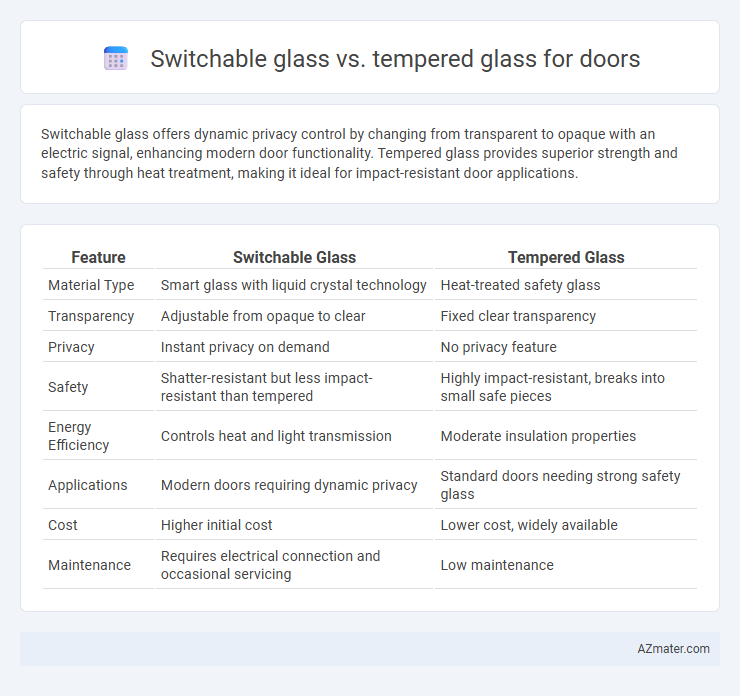Switchable glass offers dynamic privacy control by changing from transparent to opaque with an electric signal, enhancing modern door functionality. Tempered glass provides superior strength and safety through heat treatment, making it ideal for impact-resistant door applications.
Table of Comparison
| Feature | Switchable Glass | Tempered Glass |
|---|---|---|
| Material Type | Smart glass with liquid crystal technology | Heat-treated safety glass |
| Transparency | Adjustable from opaque to clear | Fixed clear transparency |
| Privacy | Instant privacy on demand | No privacy feature |
| Safety | Shatter-resistant but less impact-resistant than tempered | Highly impact-resistant, breaks into small safe pieces |
| Energy Efficiency | Controls heat and light transmission | Moderate insulation properties |
| Applications | Modern doors requiring dynamic privacy | Standard doors needing strong safety glass |
| Cost | Higher initial cost | Lower cost, widely available |
| Maintenance | Requires electrical connection and occasional servicing | Low maintenance |
Introduction to Switchable Glass and Tempered Glass
Switchable glass, also known as smart glass, features electrochromic technology that allows it to change from transparent to opaque with the flip of a switch, providing privacy and energy efficiency for doors. Tempered glass is a type of safety glass strengthened through controlled heating and rapid cooling, offering enhanced durability and resistance to impact or shattering in door applications. Both materials serve distinct functional and aesthetic purposes, with switchable glass offering dynamic light control while tempered glass ensures structural safety.
How Switchable Glass Works
Switchable glass, also known as smart glass, operates by applying an electrical current to a liquid crystal or polymer dispersed in the glass, allowing it to change from opaque to transparent on demand. This technology contrasts with tempered glass, which is chemically or heat-treated to enhance strength and safety but remains static in appearance. Switchable glass provides privacy control and light modulation, making it ideal for modern doors where dynamic transparency is required.
Understanding Tempered Glass Properties
Tempered glass for doors offers enhanced strength and safety through a heat-treatment process that increases its resistance to impact and thermal stress compared to switchable glass. It shatters into small, blunt pieces to minimize injury risk, making it ideal for high-traffic or security-sensitive areas. Switchable glass, while providing privacy and light control via electric opacity, lacks the same level of mechanical durability inherent in tempered glass.
Comparing Privacy Features
Switchable glass offers dynamic privacy control by instantly changing from transparent to opaque with an electric current, making it ideal for environments requiring flexible privacy settings. Tempered glass provides enhanced security and durability but lacks adjustable privacy, remaining clear or frosted without the ability to alter opacity on demand. For doors prioritizing customizable privacy, switchable glass outperforms tempered glass by combining strength with advanced light control technology.
Durability and Safety Aspects
Switchable glass offers advanced safety by instantly turning opaque to provide privacy while maintaining shatter resistance, though its durability depends on the quality of embedded liquid crystal layers. Tempered glass boasts superior durability due to its heat-treatment process that increases strength and causes it to break into small, blunt pieces, drastically reducing injury risk. For door applications, tempered glass remains the industry standard for safety and impact resistance, whereas switchable glass provides additional functional benefits with comparable but slightly less impact durability.
Energy Efficiency and Light Control
Switchable glass for doors offers advanced energy efficiency by adjusting transparency to control solar heat gain and reduce HVAC loads, outperforming traditional tempered glass that provides static insulation properties. It enhances light control by toggling between opaque and clear states, allowing customizable natural lighting without compromising privacy, whereas tempered glass only allows consistent light transmission. This dynamic functionality of switchable glass contributes significantly to energy savings and improved indoor comfort in both residential and commercial door applications.
Aesthetic and Design Flexibility
Switchable glass offers unparalleled aesthetic versatility for doors by seamlessly transitioning from opaque to transparent, enabling dynamic light control and privacy without sacrificing design continuity. Tempered glass provides sleek, modern appeal with its smooth, clear surface and enhanced strength, but lacks the adaptive visual flexibility of switchable glass. Designers favor switchable glass when aiming for innovative spaces that balance openness and seclusion, while tempered glass suits minimalist and robust design priorities.
Cost Comparison: Switchable vs Tempered Glass
Switchable glass typically costs between $150 and $250 per square foot, driven by its advanced technology and installation requirements, whereas tempered glass ranges from $50 to $100 per square foot depending on thickness and customization. The higher price of switchable glass reflects its ability to switch between transparent and opaque states for privacy and energy efficiency, while tempered glass offers enhanced strength and safety at a more affordable price point. Homeowners and businesses must weigh the significant cost difference against functional benefits when selecting glass for doors.
Applications in Door Installations
Switchable glass enhances privacy and energy efficiency in door installations by instantly changing from transparent to opaque, ideal for conference rooms, bathrooms, and residential entryways. Tempered glass offers superior strength and safety, making it suitable for high-traffic doors, commercial entrances, and areas requiring impact resistance. Both materials provide unique benefits, with switchable glass prioritizing dynamic privacy control and tempered glass ensuring durability and safety.
Choosing the Right Glass for Your Door
Choosing the right glass for your door depends on functionality and privacy needs; switchable glass offers dynamic opacity control, allowing for instant privacy and light modulation, ideal for modern smart homes and offices. Tempered glass provides superior strength and safety, shattering into small, blunt pieces on impact, making it suitable for high-traffic areas requiring durability and compliance with safety standards. Consider the balance between technological benefits and structural security when selecting between switchable glass and tempered glass for optimal door performance.

Infographic: Switchable glass vs Tempered glass for Door
 azmater.com
azmater.com